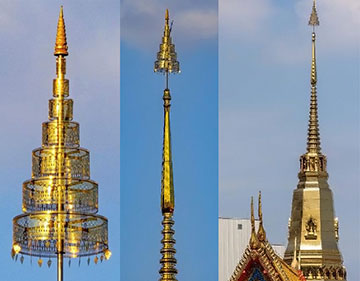
A seven-tiered umbrella, constructed with laser techniques, was installed at the top of the pagoda of Wat That Thong, Bangkok, Thailand. [Image: Pichet Limsuwan]
New work demonstrates how laser technology can help Thailand preserve and continue one of its oldest traditions: the ornate tiered umbrellas that sit inside or atop temples and palaces (J. Laser Appl., doi: 10.2351/7.0001370). The intricately patterned metal umbrellas, called “chats” in Thai and “chatras” in Sanskrit, take well-trained artisans as long as six months to construct. With CO2 lasers and a slight change in materials, researchers from several laboratories in Thailand have demonstrated how to reduce the time needed to create the delicate decorations.
The meaning of tiered umbrellas
For 1,400 years, Thai chats have symbolized honor in both royal and religious contexts. The coaxial cylindrical umbrellas, decorated with complex cutout patterns, are grouped in odd-numbered stacks of three to nine tiers, with the narrowest at the top and the widest at the bottom. Only the reigning (officially crowned) monarch of Thailand is permitted to sit under the nine-tiered chat, with five or seven tiers symbolizing heirs to the throne or royal patronage of temples.
Chats also adorn the exteriors of more than 29,000 “wats,” or Thai Buddhist temples, located throughout the country’s 77 provinces. Most are made of brass, a durable alloy of copper and zinc, to resemble yellow gold, an important traditional color.
According to physicist Pichet Limsuwan, King Mongkut’s Institute of Technology, more than 50 tiered umbrellas must be repaired each year. Every new wat needs a new chat, too. Each chat has been constructed through a painstaking process: drawing the pattern manually on paper, transferring the design onto a brass plate, drilling and cutting the pattern out by hand and polishing everything until it shines.
Speeding up the work
According to physicist Pichet Limsuwan, King Mongkut’s Institute of Technology, more than 50 tiered umbrellas must be repaired each year.
Today, high-powered, computer-controlled lasers can make rapid cuts and etched patterns into metal surfaces. When evaluating materials for this project, however, Limsuwan and his team could not find any reports of laser-cutting of brass in the literature. Also, copper’s reflectance value at wavelengths around 1 μm is roughly 90%, making it too reflective to be well suited for laser cutting. The researchers instead selected stainless steel made of 71% iron, 18% chromium, 8% nickel and trace amounts of other elements, which is also more cost-effective than copper.
For the cutting, Limsuwan’s group chose a commercial CO2 laser operating at a 10.6-μm wavelength and a 5-kHz pulse frequency. The laser made cuts through the 2-mm-thick steel sheets at 165 mm/s. Since stainless steel doesn’t look like brass, the team finished off the chat tiers with a titanium nitride (TiN) coating, laid down with a commercial physical vapor deposition system.
As a proof of concept, the researchers fabricated a new chat to replace the weathered seven-tiered one atop a temple named Wat That Thong. From a hand drawing of the old umbrella’s design, the team transferred the pattern to the computer controlling the laser-cutting system. The workers rolled the seven cut-steel sheets into cylinders before depositing the TiN film to give the tiers the characteristic gold color.
The researchers estimated that the process took about 113 hours, or five days, to complete. In practice, it might take a month or two from start to finish, which is still less than the typical three to six months. Limsuwan says his team’s biggest challenge was to learn more about the history and meaning of these tiered umbrellas and their designs.
